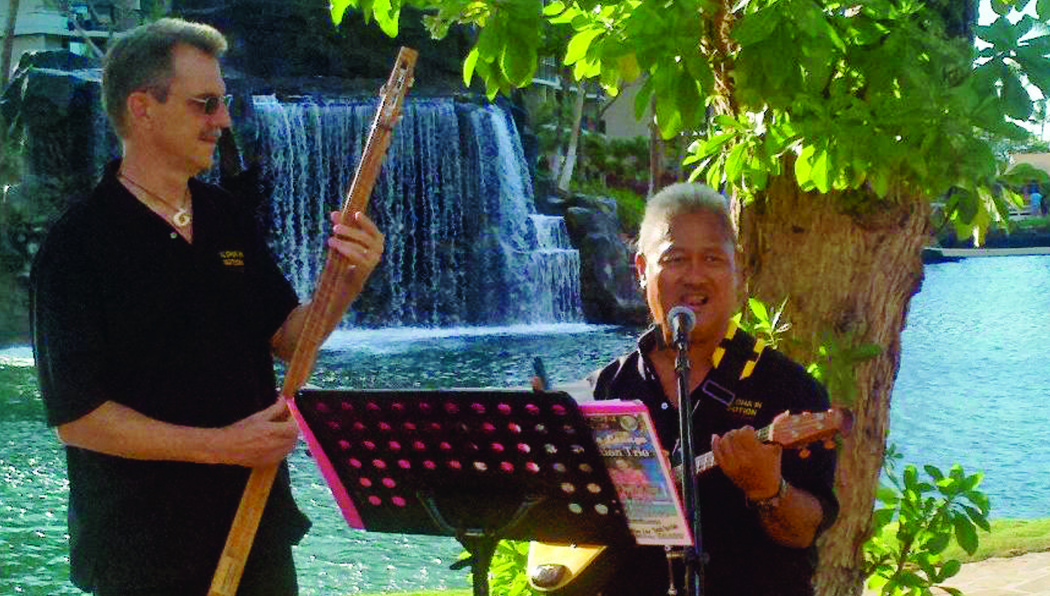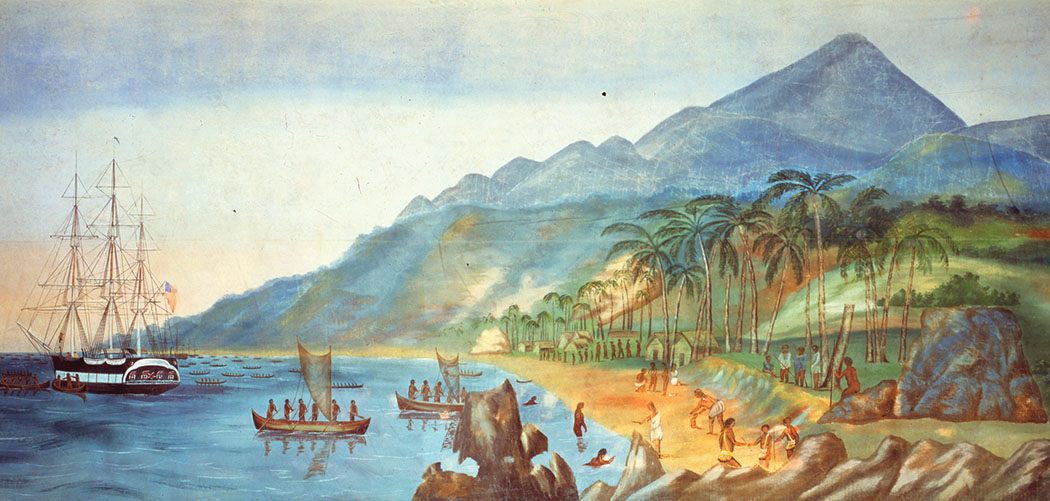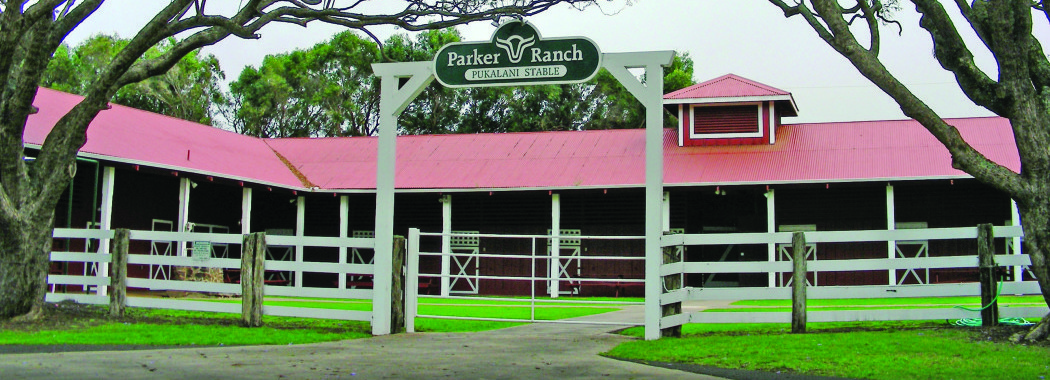
Konabob and the Unique Kona Walkingbass
 By Shirley Stoffer
By Shirley Stoffer
Bob Stoffer, known as “Konabob” to many people in Hawai’i and around the world, had loved Hawai’i and Hawaiian music for a long time before moving to the island. He listened to Hawaiian music at his bakery in the mountains of Colorado, with a picture of Gabby Pahinui and a map of Hawai‘i Volcanoes National Park on the walls, and Kona coffee in the thermoses on the counter.
Ever since living in Waimea for a year in 1985, he had always wanted to move back. In 1995, he did, along with wife Shirley.
Though he was always musically inclined, Bob had never studied an instrument before moving to Hawai’i, and was a rather frustrated musician. One night, after he’d been living on the island a few years, he had a dream that he was playing the Hawaiian steel guitar in front of a large audience. The next day, he asked his mother-in-law if she’d bring over the steel guitar that had been her husband’s and was sitting, unplayed in her garage in Denver.
She complied and Bob played around with it on his own, but things didn’t click, he says, until 1999, when steel guitar wizard Ken Emerson of “Slack and Steel” album fame came to the Big Island from Kaua’i to play a concert in Hawai’i Volcanoes National Park. Bob grabbed the chance to talk with Ken after the show, inquiring about the tuning he used.
“That conversation sparked a fire in me,” Bob says. “I’d tried other tunings, but they were more applicable to Country Western or bluegrass music. Ken’s tuning was the key I needed to unlock that ‘Hawaiian sound’ I had been hoping to find. The steel guitar has a lush, romantic sound that really appeals to me: it’s fretless, so it can evoke emotions in much the same way as the human voice.” Ken later played on one of the first Hawaiian albums to win a Grammy award.
Right around the time Bob went to see Ken Emerson in concert for the first time, he and Shirley also went to hear Maggie Lobo’s bluegrass band, the Voggy Mountain Ramblers, in Kona, with a friend who played banjo and also loved bluegrass music. Shirley, too, caught the music fever, and, soon after that, “I had my mother bring over the violin I hadn’t touched for a dozen years and I started trying to learn fiddle,” she says.
Maggie was losing some of her band members to the mainland, and soon she had new members of the band!
“Maggie took a chance on us. Her generosity was the beginning of my musical career,” Bob says. The group had a standing gig at the Kona Brew Pub for years, and at the annual Brewfest.
Mainly through kani ka pila (jamming) with kūpuna for years (specifically, Kona aunties Loretta Sherlock, Leilani Belanio and the late Ella Neula), Bob became adept at playing Hawaiian music, and has played in a few Hawaiian music bands through the years: first with Lenard Kaniho and wife, Shirley, in the group Hana Aloha, and currently wth Bobby Koanui and Rupert Adarme in Aloha in Motion Trio. He says he’s also very honored to play steel guitar with The Ladies of Waiku’i (Rolinda Bean, Mana Leonah and Aunty Kaipo Harris) at the Keauhou Beach Resort’s Verandah Lounge.
Bob also plays steel with the Merrie Monarchs Men’s Glee Club, led by Joe Spencer, at Hulihe’e Palace. “My connection with Hawaiian music opened doors for me here that I could never have dreamed of,” he says. “After it became known that my love for it was sincere and deep, I was given access to a side of Hawai’i you just don’t see as a tourist—baby lu‘au, local parties, the ‘inside scoop’ on songs and cultural tidbits shared by local musicians and kūpuna. I’ve even been flown to Okinawa and Lana’i to play for hula festivals! I am so grateful.”
Nothing would please Bob more, he says, than to see the Hawaiian steel guitar regain the prominence it once had in Hawaiian music. “Many times at music gigs I have been asked what instrument I’m playing. People—even many Hawaiians—don’t realize that the steel guitar was invented by a Hawaiian. Joseph Kekuku, of O’ahu, invented the steel guitar technique in 1889. He experimented with sliding different objects—a bolt, the back of a pen knife, a steel comb—across the strings of a guitar to see what sounds could be produced. It eventually led to the use of a highly polished steel bar, as is used now.”
When Kekuku was 30, he played the instrument in vaudeville shows on the mainland—from coast to coast—and then went on an eight-year tour of Europe with “The Bird of Paradise Show,” which had played on Broadway. People all over the world fell in love with the sound of the steel guitar. In the ‘30s, when the steel guitar went electric, it was discovered by Nashville and Hollywood in a big way, and many Hawaiian musicians left
for the mainland.
The lilting, sweet sound of the steel guitar that would always be associated with Waikiki in the memories of tourists and GIs stationed on O’ahu during the war, became harder and harder to find in Hawai‘i as the years went by. The younger generations were more interested in playing rock and roll, and later, “Jawaiian,” a reggae-Hawaiian hybrid.
Today, Bob is encouraged about the future of the instrument. He teaches steel guitar at Keoki Kahumoku’s annual Music and Lifestyle Camp each November, to kids and adults, and says, “I‘m starting to see what I hope is a trend among the younger kids at that camp. Rhythm-based music is still a big part of their lives, but I’m seeing more enthusiasm for exploring melody-based music. Of course, the steel guitar is perfect for that.”
He also has taught steel guitar at the Beamer ‘ohana’s Aloha Music Camp to people who, in general, have come to Hawaiian music later in life, and, like Bob, have a sincere love for the music and the culture. “They are dedicated to perpetuating traditional Hawaiian music, and many of them are also writing their own songs! I really enjoy seeing people blossom at these camps,” he says. Bob is now the on-site manager for Aloha Music Camp.
In 2003, Bob decided he wanted to learn how to play the bass. This led to his invention of the Kona Walkingbass, a three-string electro-acoustic portable bass. The prototype was a takeoff on the Hawaiian pā kini bass, which is similar to the washtub bass of the Appalachians. Bob’s first attempt also had one string, and was made with a piece of two-by-four and some weedwhacker string. It also had an ‘ukulele pickup.
“I was immediately surprised at how good it sounded through an amplifier, so I decided to make an amplified bass,” he says. He designed it so it was tuned to the Hawaiian “Taro Patch G” tuning and could be “bar chorded” with one finger like a steel guitar. The Kona Walkingbass has three strings instead of the four found on a standard bass. “It made it simpler to play that way—a basic chord only has three notes!” he says. “The average person can learn to play bass in this tuning in 20 minutes.” He’s now sold 250 of the Kona Walkingbasses to people all over the world, including two to the famous Langley Schools in British Columbia, which are famous for their ‘ukulele programs, and two to the University of Missouri Music Dept., which uses them to teach their bass players to “think outside the box”. Since early on, neighbor and world-class fine woodworker, Tai Lake, and his sons, were involved in the process, making furniture-quality “blanks” for Bob’s basses. Out of mango and Big Island koa, they carved this totally new instrument. There’s a video of Bob playing the Walkingbass with Ledward Ka’apana on YouTube that’s received over 15,000 hits.
Bob is one of the few Hawaiian musicians who performs on instruments he has made himself. So far, he has made one acoustic steel guitar, with the help of Na’alehu luthier, Dennis Lake, and three electric steel guitars. He plays one of the solid-body electric steels at his Keauhou Beach Resort sunset gig. “It’s perfect!” he says. “It’s really got that ‘Waikiki sound’.” ❖
Contact writer Shirley Stoffer at Shirley@konaweb.com.
Bob and Shirley Stoffer founded www.konaweb.com when they moved to Hawai‘i. It’s become a popular forum, especially for people planning to move to the Big Island. Today Konaweb is a community in itself, with over 5,500 members signed up for its forums and an average of 1,500 individuals visiting the site every day. There are even “Konaweb Parties” once a month, where members of the site can meet and talk story. Members on the mainland have even hosted Konaweb parties themselves, to fuel their enthusiasm for the island until they can return.
Konabob’s Famous Lilikoi Cheesecake recipe: www.konaweb.com/forums/cheesecake.html
Aloha in Motion Trio: www.alohainmotiontrio.com
The Ladies of Waiku’i: www.konaweb.com/ladies


